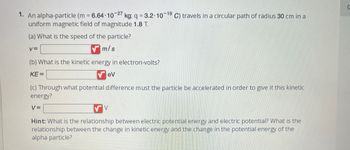Question

Transcribed Image Text:1. An alpha-particle (m = 6.64-10-27 kg; q = 3.2.10-19 C) travels in a circular path of radius 30 cm in a
uniform magnetic field of magnitude 1.8 T.
(a) What is the speed of the particle?
m/s
V=
(b) What is the kinetic energy in electron-volts?
KE=
eV
(c) Through what potential difference must the particle be accelerated in order to give it this kinetic
energy?
V=
V
Hint: What is the relationship between electric potential energy and electric potential? What is the
relationship between the change in kinetic energy and the change in the potential energy of the
alpha particle?
0
Expert Solution
This question has been solved!
Explore an expertly crafted, step-by-step solution for a thorough understanding of key concepts.
Step by stepSolved in 3 steps with 2 images

Knowledge Booster
Similar questions
- In a nuclear experiment a proton with kinetic energy 8.5 MeV moves in a circular path in a uniform magnetic field. If the magnetic field is B = 2.8 T what is the radius of the orbit? What energy must an alpha particle (q = +2e, m = 4.0 u) and a deuteron (q = +e, m = 2.0 u) have if they are to circulate in the same orbit? Energy of the alpha? (MeV) Energy of the deuteron?arrow_forward2. A source injects an electron of speed v = 1.5 x 107 m/s into a uniform magnetic field of magnitude B = 1.0 x 10-8 T. The velocity of the electron makes an angle 0 = 10° with the direction of the magnetic field. Find the distance d from the point of injection at which the electron next crosses the field line that passes through the injection point. The electric charge and the mass of an electron are qe = -1.60 x 10-19 C and me = 9.11 × 10-31 kg, respectively.arrow_forwardPhysics 6. A loop of area 0.250 m2 is in a uniform 0.020 0-T magnetic field. If the flux through the loop is 3.8310-3 T·m2, what angle does the normal to the plane of the loop make with the direction of the magnetic field?arrow_forward
- An electron moves in a circular path perpendicular to a magnetic field of magnitude 0.280 T. If the kinetic energy of the electron is 2.60 x 10-19 J, find the speed of the electron and the radius of the circular path. (a) the speed of the electron X Your response differs from the correct answer by more than 10%. Double check your calculations. m/s (b) the radius of the circular path X Your response differs from the correct answer by more than 10%. Double check your calculations. μmarrow_forward9. A electron with charge -1.60 × 10-19 C and mass 9.11 × 10-31 kg is accelerated from rest through 14.20 kV. It then enters a uniform magnetic field of 7.50 x 10-4 T that is oriented perpendicular to its direction of motion. (a) What is the radius of the path the electron follows in the magnetic field? (b) How long does it take the electron to make one complete circle in the magnetic field?arrow_forward7. An electron is accelerated through 2.40 × 103 V from w rest and then enters a uniform 1.70-T magnetic field. What are (a) the maximum and (b) the minimum val- ues of the magnetic force this particle experiences? volocityI of =arrow_forward
arrow_back_ios
arrow_forward_ios